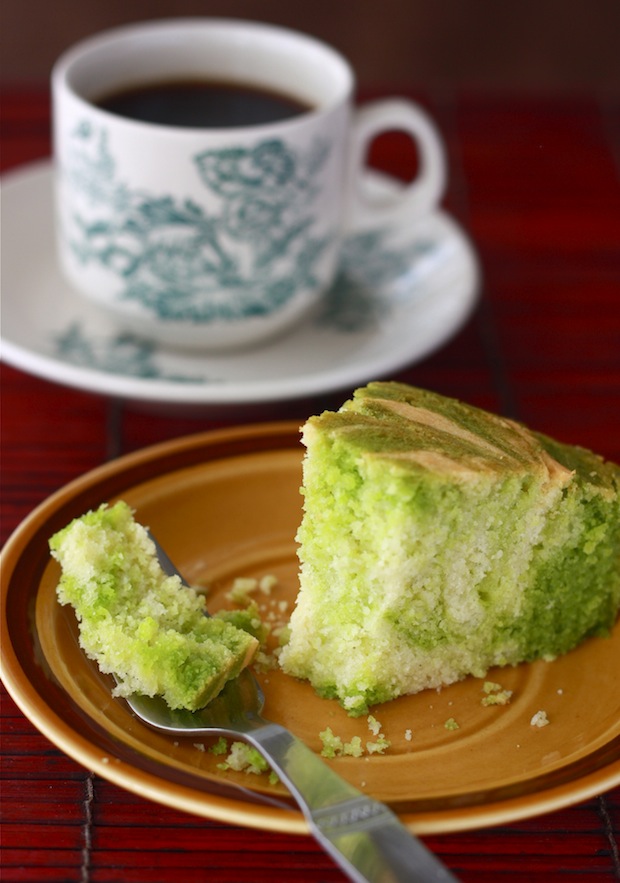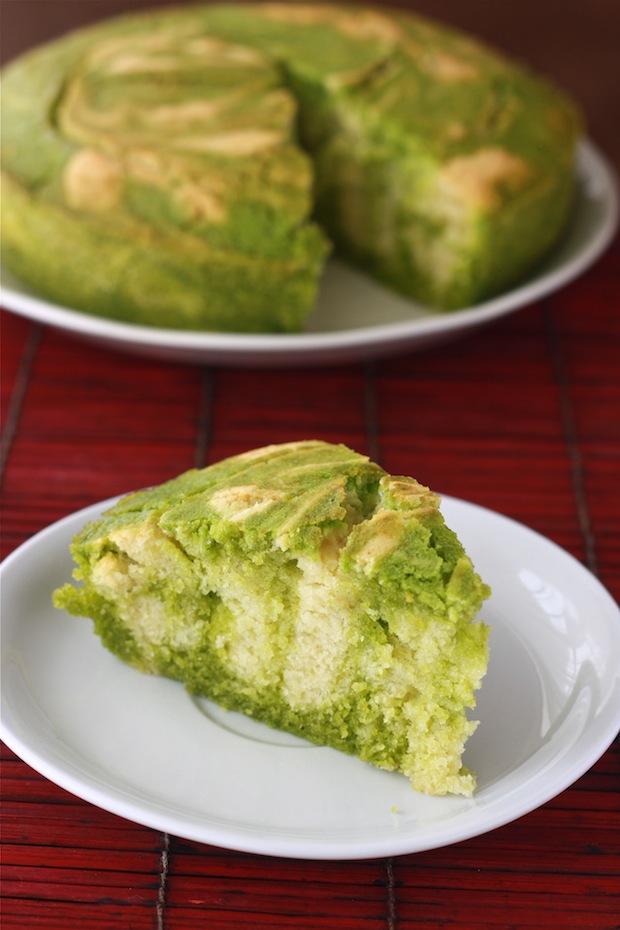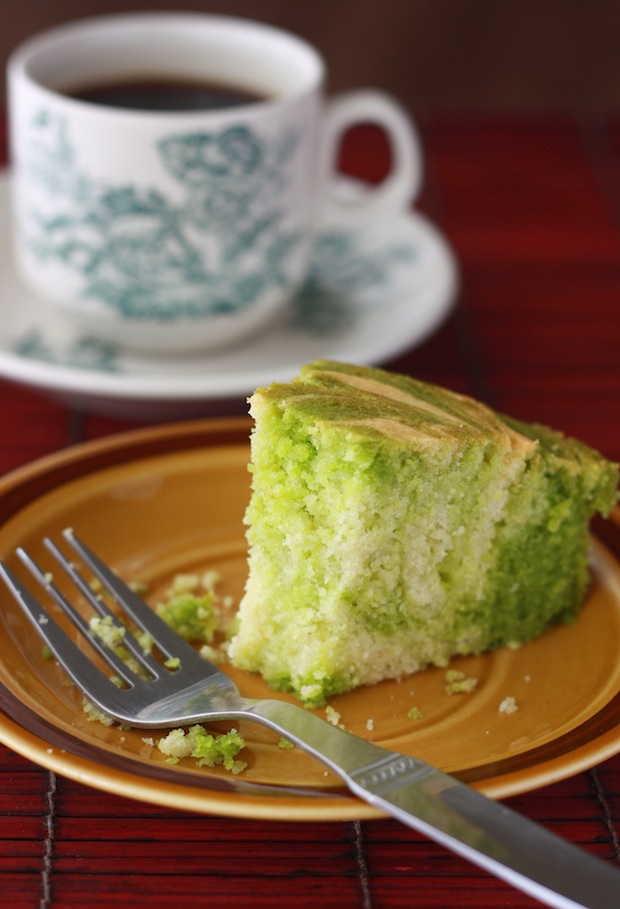For a new twist on a familiar cake recipe, swirl Vanilla and Asian Vanilla together for a Green & Gold Pandan Vanilla Marble Cake. The rich, green pandan leaves (Asian Vanilla) impart a distinctly warm, nutty, sweet, vanilla-like aroma to complement the golden swirls of traditional vanilla.
A marble cake for the ultimate vanilla fan.
A marble cake for the ultimate vanilla fan.
To make a natural pandan extract, it’s as easy as blending together the leaves with water.
Buy fresh pandan leaves, and then wait for 2-3 days until the leaves begin to wilt and you can smell the strong vanilla-like aroma of pandan emerge. It may be tempting to use them earlier, but patience is a must. If you blend the leaves too early, you’ll recognize that sharp grassy smell of freshly mowed lawn.
Traditionally, pandan leaves are pounded in a mortar, which is the best method to limit oxidation. But after a minute or so of exerting all your energy – and looking around to find a messy green splattered all over your kitchen – you’ll realize that the extra oxidation from using a blender is a small price to pay.
Once the pandan leaves are blended with a bit of water, just strain out the fibers and add that green liquid into one third of the cake batter. This method unfortunately adds water to your batter, so depending on the marble cake recipe you are using, you will need to make the necessary adjustments, e.g. reducing the milk or egg whites, or increasing the dry ingredients.
A quicker and easier option is to use packaged pandan paste that adds flavor and color without the unnecessary liquid. But keep in mind that pandan paste has artificial coloring and sometimes artificial flavoring. It would be comparable to using vanilla essence instead of the real vanilla extract.
Try adding pandan into your favorite marble cake recipe. Replace the chocolate with pandan for a Green & Gold cake, or replace the vanilla for a Green & Brown Pandan Chocolate marble cake.
Pandan Vanilla Marble Cake recipe by Season with Spice
Ingredients:
Vanilla batter -
1 1/2 cups flour
1 1/2 tsp baking powder
2 pinches of salt
120g butter – softened
1/2 cup sugar
2 egg whites
1/4 cup coconut water (or plain water)
1/4 cup milk
1 tsp vanilla extract or vanilla paste
Pandan batter -
3/4 cup flour
3/4 tsp baking powder
1 pinch of salt
60g butter – softened
1/4 cup sugar
1 egg white
1/4 cup pandan extract (see Step 1 of process)
Process:
1. With a food scissors, cut three pandan leaves (slightly wilted leaves) into small pieces, and add to a blender. Then add in one tablespoon of water at a time until the leaves blend into a fibrous, green mix. Finally, pour through a strainer, and squeeze the fibers to release all the green water. Set bowl of pandan water aside.
2. Preheat oven to 350F (175C). Grease a 9-inch round cake pan with butter.
3. In two separate bowls, mix the dry ingredients (flour, baking powder, salt). Set aside.
4. In another two separate bowls, cream together the sugar and butter. Then mix in the remaining ingredients.
5. Add the dry ingredients into the wet ingredients, and combine well, but being careful not to overwork the batter.
6. Take turns adding the vanilla and pandan batter to the pan – using the ratio of two spoonfuls of vanilla batter to one spoonful of pandan batter. Once the batter is all in the pan, it is important to lightly bang the bottom of the pan on the counter until all of the air bubbles in the batter are gone. Finally, use a knife to swirl patterns into the batter.
7. Bake for around 45 minutes – it’s done when a toothpick poked in the middle comes out clean. When done, set on a cooling rack for at least 15 minutes before serving.
Notes:
- My pandan marble cake cracked quite a bit on top. To help prevent cracking (even though it does make the cake look more appetizing), keep in mind my mistakes:
1. My oven in Asia heats up really quick on top causing the cake to rise too fast. When baking, place the cake on the center rack and be careful not to set the temperature above what’s stated in the recipe.
2. I’m impatient, opening the door of the oven to check too often. This will make the temperature of the oven fluctuate, effecting the baking process. Keep that oven door closed, allowing the cake to bake at a steady temperature.
3. I added too much baking powder causing the cake to rise too much. I’ve decreased the amount in my recipe here.
4. I left too much air in the batter, causing cracks and bubbles to form as the air escaped during baking. Two reasons for this - I overmixed the batter (the lesson I never seem to learn), and I didn’t lightly bang the cake enough to release all the trapped air.
Ingredients:
Vanilla batter -
1 1/2 cups flour
1 1/2 tsp baking powder
2 pinches of salt
120g butter – softened
1/2 cup sugar
2 egg whites
1/4 cup coconut water (or plain water)
1/4 cup milk
1 tsp vanilla extract or vanilla paste
Pandan batter -
3/4 cup flour
3/4 tsp baking powder
1 pinch of salt
60g butter – softened
1/4 cup sugar
1 egg white
1/4 cup pandan extract (see Step 1 of process)
Process:
1. With a food scissors, cut three pandan leaves (slightly wilted leaves) into small pieces, and add to a blender. Then add in one tablespoon of water at a time until the leaves blend into a fibrous, green mix. Finally, pour through a strainer, and squeeze the fibers to release all the green water. Set bowl of pandan water aside.
2. Preheat oven to 350F (175C). Grease a 9-inch round cake pan with butter.
3. In two separate bowls, mix the dry ingredients (flour, baking powder, salt). Set aside.
4. In another two separate bowls, cream together the sugar and butter. Then mix in the remaining ingredients.
5. Add the dry ingredients into the wet ingredients, and combine well, but being careful not to overwork the batter.
6. Take turns adding the vanilla and pandan batter to the pan – using the ratio of two spoonfuls of vanilla batter to one spoonful of pandan batter. Once the batter is all in the pan, it is important to lightly bang the bottom of the pan on the counter until all of the air bubbles in the batter are gone. Finally, use a knife to swirl patterns into the batter.
7. Bake for around 45 minutes – it’s done when a toothpick poked in the middle comes out clean. When done, set on a cooling rack for at least 15 minutes before serving.
Notes:
- My pandan marble cake cracked quite a bit on top. To help prevent cracking (even though it does make the cake look more appetizing), keep in mind my mistakes:
1. My oven in Asia heats up really quick on top causing the cake to rise too fast. When baking, place the cake on the center rack and be careful not to set the temperature above what’s stated in the recipe.
2. I’m impatient, opening the door of the oven to check too often. This will make the temperature of the oven fluctuate, effecting the baking process. Keep that oven door closed, allowing the cake to bake at a steady temperature.
3. I added too much baking powder causing the cake to rise too much. I’ve decreased the amount in my recipe here.
4. I left too much air in the batter, causing cracks and bubbles to form as the air escaped during baking. Two reasons for this - I overmixed the batter (the lesson I never seem to learn), and I didn’t lightly bang the cake enough to release all the trapped air.








